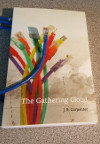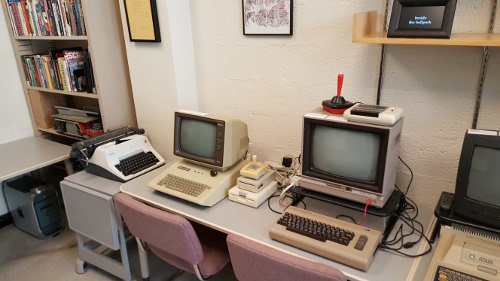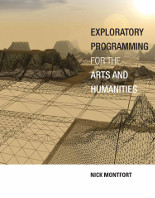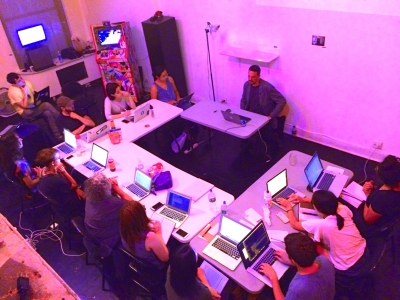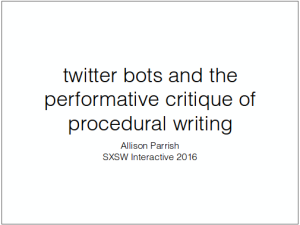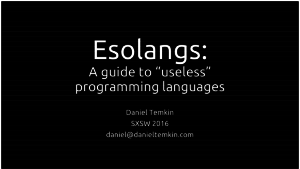J.R. Carpenter’s book is an accomplishment, not just in terms of the core project, but also by virtue of how the codex is put together. The introduction is by Jussi Parikka, the after-poem by Lisa Robertson. While social media and ethereal imaginations of the network keep us from being lonely as a cloud these days, they obscure the material nature of computing, the cost of linking us in terms of wire and heat. Carpenter’s computer-generated Generation[s] was concerned with the computational production of text; The Gathering Cloud also engages with the generation of power. This book and the corresponding digital performance, for instance at the recent ELO Festival in Porto, yields up the rich results of research, cast in accomplished verse. As with Carpenter’s other work that is rooted in zines and the handmade Web, it is personal rather than didactic. Deftly, despite the gravity of the topic, the book still affects the reader with a gesture, not a deluge of facts — more by waving than drowning.
C-Creativity, my talk at the KDD workshop on ML and Creativity
Update: I have posted 360 video of my talk with subtitles. If you rotate it, you don’t have to look at the large brown pillar that is in “front” the whole time. Previously: Here are my slides from “C-Creativity: Cultural Creativity or, Why is there no middle C?,” the talk I just gave in Halifax. There are no text notes, and they don’t represent what I said very closely, but if they remind people who were there of my comments, that’s great. And if they provoke any questions, feel free to get in touch on the blog or by email.
“Renderings” article now online
“Renderings: Translating literary works in the digital age” by Piotr Marecki & Nick Montfort has been published, and is available online.
My @party Talk on Computer-Generated Books
I just gave a talk at the local demoparty, @party. While I haven’t written out notes and it wasn’t recorded, here are the slides. The talk was “Book Productions: The Latest in Computer-Generated Literary Art,” and included some discussion of how computer-generated literary books related to demoscene productions.
Sliders
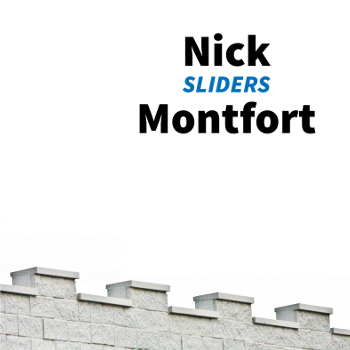
My minimal book Sliders has been published by my press, Bad Quarto. The book contains 32 poems, some of which are only one word long. In a break from tradition, they are not computer-generated.
Currently Sliders is only available for sale at the MIT Press Bookstore, 301 Massachusetts Ave, Cambridge, Mass.
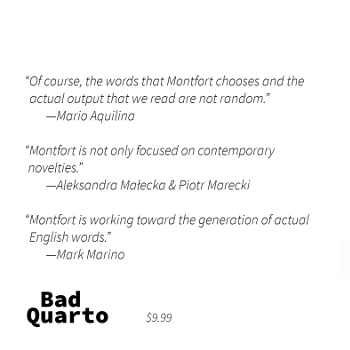
Salon 256 on May 1
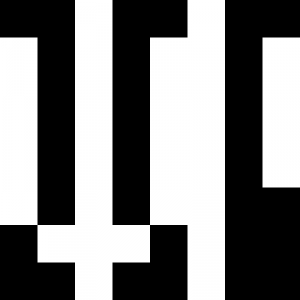
SALON 256 is a forum for presentation and discussion of very small creative computer programs. Such programs have featured in digital art and poetry, electronic literature, computer music, and the demoscene.
YOU are invited to present a tiny program of yours:
Monday May 1 . 5pm-7pm . MIT’s 14E-304
Presenters already confirmed:
- Mike “Dr.Claw” Piantedosi
- Angela Chang
- Sofian Audry
- Nick Montfort
- Chris Kerich
- Willy Wu
- Henry Lieberman
- Doug Orleans
Programs in an interpreted language are fine, as long as the code is 256 bytes or less; compiled programs with an executable file of 256b or less are fine, too.
Building 14 also holds the Hayden Library and is not Building E14.
If you’d like to present, leave a comment or sign up at the event.
A Purple Blurb / The Trope Tank production.
Tiny Trope Tank Productions
Recently, at the suggestion of our writer in residence, Milton Läufer, we in the Trope Tankt have been producing digital files for discussion at meetings. These productions, almost always computer programs but not constrained to be such, must be at most 256 bytes.
It’s been extremely productive in terms of thinking about digital media, platforms and programming languages, and how we approach creative projects — and even other projects — generally. Postdoctoral researcher Sofian Audry prompted us to discuss this some at the last meeting.
So far we have three sets of 256b files which have landed in this directory, organized by date and with file names that indicate who wrote what:
http://nickm.com/trope_tank/256/
They include work by RA Chris Kerich, who has produced rather demoscene-like visual effects using Python running in a terminal, and by postdoctoral researcher Angela Chang, who has provided short example programs for use in teaching. Angela’s examples show that you don’t have to have hypercompressed, confused code when you write short, interesting programs. You can value clarity and pedagogical usefulness if you like, or you can pack in as much as possible, for instance, in order to produce a visual effect.
Sofian has explored creative computing history by writing a 256b Commodore 64 BASIC program that implements, or at least strongly refers to, the classic Lemonade Stand BASIC program. Milton has generated various compelling visual displays. His and Chris’s most recent programs are less clearly mathematical and regular, instead imitating the natural world.
It was very apropos that Christian Bök pointed me to Dwitter, a framework for making tiny programs that can be easily shared on the Web, just recently. I’m sure we’ll all dig into that soon.
My pieces include one bash script, one Python 3 program, and an executable of 256b written in assembly for the Commodore 64. The Python 3 program is actually a very tiny text adventure, Wastes, and is listed on the Interactive Fiction Database. In fact, I’m pleased to see that at this point, it has one four-star (our of five) review!
Multisequential Books in the Trope Tank
We now keep the latest bibliography of MIT Trope Tank books on the Trope Tank’s Interactive Narrative Collection page.
—Update of September 1, 2023
Happy New Year 2017
My New Year’s poem for 2017 is Colors, a 1KB Web page, online at http://nickm.com/poems/colors.html and here it is, too:
<!DOCTYPE html> <html style="overflow:hidden"> <head><meta charset=utf-8> <!-- Copyright (c) 2016 Nick Montfort <nickm@nickm.com> 2016-12-31, 1KB
Copying and distribution of this file, with or without modification, are permitted in any medium without royalty provided the copyright notice and this notice are preserved. This file is offered as-is, without any warranty.
Click pauses, Add ?00f000 or similar to URL for the specified color.-->
<script type=text/javascript>
var c = 0, i;
function up() {
if (c > 16581375) { c = 0; }
document.body.style.background = "#"+("00000"+c.toString(16)).slice(-6);
c += 1;
}
function pause(e) {
if (i) { clearInterval(i); i = 0; } else { go(); }
}
function init() {
var s = window.location.search;
if (s.slice(0, 1) === '?') { c = parseInt(unescape(s.slice(1)), 16); }
go();
}
function go() { i = window.setInterval(up, 5); };
</script>
<title>Colors</title></head>
<body onload=init() onmousedown=pause(event)>
<div style="width:100vw; height:100vh"></div>
</body>
</html>
As the code says, you can add an argument in the URL to start with a particular color, such as medium gray:
http://nickm.com/poems/colors.html?808080
Click to stop on a particular color that you especially like. Click again to continue moving through the colors. If you let it run, you’ll see all 16581375 colors in just over 23 hours.
Happy new year.
Digital Lengua, the launch of 2×6 and Autopia, Nov 20 in NYC
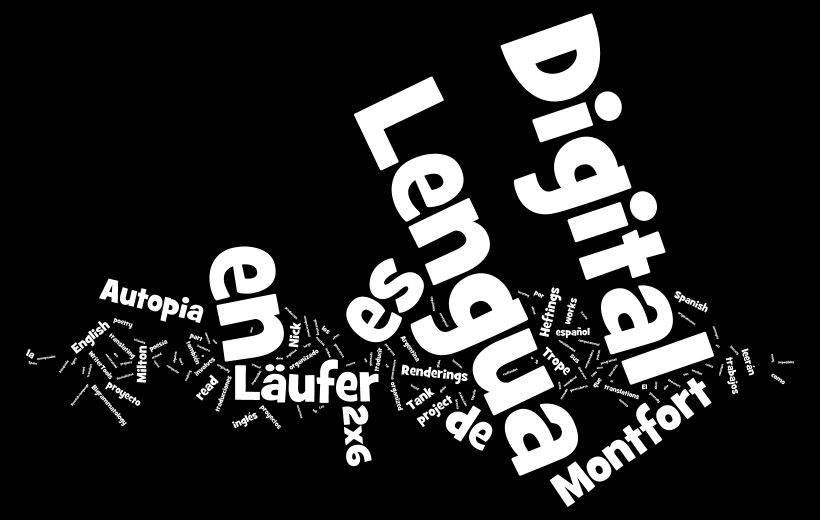
Digital Lengua – Babycastles, 137 West 14th St, Manhattan –
5:30pm Sunday November 20
This reading of computer-generated literature in English and Spanish
serves as the global book launch for two titles:
2×6
Nick Montfort, Serge Bouchardon, Andrew Campana, Natalia Fedorova,
Carlos León, Aleksandra Ma?ecka, Piotr Marecki
Les Figues, Los Angeles: Global Poetics Series
http://lesfigues.com/book/2×6/
256 pp.
Autopia
Nick Montfort
Troll Thread, New York
http://trollthread.tumblr.com/post/152339108524/nick-montfort-autopia-troll-thread-2016-purchase
256 pp.
Montfort will read from these two books, reading English and Spanish
texts from 2×6. Paperback copies will be available for purchase. The
short programs that generated these books are printed in the books and also
available as free software online.
Läufer will read from his projects Bigrammatology and WriterTools™, in
both cases, in Spanish and English.
Montfort and Läufer will read from work done as part of the Renderings
project and as part of another project, Heftings.
The Renderings project, organized by Montfort and based at his
lab, The Trope Tank, involves locating computational literature (such as
poetry generating computer programs) from around the globe and translating
these works into English. Läufer and Montfort will read from two
Spanish-language poetry generators, from Argentina and Spain, and from
translations of them.
The Heftings project, also organized by Montfort through The
Trope Tank, involves making attempts, often many, at translating conceptual,
constrained, concrete & visual, and other types of literary art that are
generally considered to be impossible to translate. Montfort and Läufer will
read from some short works that are originally in Spanish or English and
works that have Spanish or English translations.
Nick Montfort develops computational art and poetry, often
collaboratively. His poetry books are #!, Riddle & Bind, and
Autopia; he co-wrote 2002: A Palindrome Story and 2×6. His
more than fifty digital projects, at http://nickm.com, include the
collaborations The Deletionist, Sea and Spar Between, and the
Renderings project. His collaborative and individual books from the MIT
Press are: The New Media Reader, Twisty Little Passages, Racing the Beam,
10 PRINT CHR$(205.5+RND(1)); : GOTO 10, and most recently Exploratory
Programming for the Arts and Humanities. He lives in New York and
Boston, offers naming services as Nomnym, and is a professor at MIT.
Milton Läufer is an Argentinian writer, journalist and teacher.
Currently he is doing a PhD at New York University focused on digital
literature in Latin America. He is the 2016-2017 writer-in-residence of
The Trope Tank, MIT. In 2015 he published Lagunas, a partially
algorithmic-generated novel, which —as most of his work— is available online
at http://www.miltonlaufer.com.ar. He has participated in art exhibitions in
Latin America, the US and Europe. He lives in Brooklyn.
Digital Lengua – Babycastles, 137 West 14th St, Manhattan – 5:30pm Domingo, Noviembre 20
Esta lectura de literatura generada por computadora en español e inglés
oficiará, a la vez, de lanzamiento para los siguientes dos títulos:
2×6
Nick Montfort, Serge Bouchardon, Andrew Campana, Natalia Fedorova,
Carlos León, Aleksandra Ma?ecka, Piotr Marecki
Les Figues, Los Angeles: Global Poetics Series
http://lesfigues.com/book/2×6/
256 págs.
Autopia
Nick Montfort
Troll Thread, New York
http://trollthread.tumblr.com/post/152339108524/nick-montfort-autopia-troll-thread-2016-purchase
256 págs.
Montfort leerá de ambos libros, en español e inglés para el caso de
2×6. Habrá copias impresas disponibles para su compra. Los breves
programas que generan el código se encuentran en dichos libros y también en
línea como software libre (y gratuito).
Läufer leerá de sus proyectos Bigrammatology y WriterTools™, en español e inglés en ambos casos.
Los autores leerán también de los trabajos realizados en el marco de los
proyecto Renderings y Heftings.
El proyecto Renderings, organizado por Montfort con base en su
laboratorio, The Trope Tank, involucra la búsqueda de literatura
computacional (tal como poesía generada por programas de computadora) a lo
largo del globo y la traducción de estos proyectos al inglés. Läufer y
Montfort leerán de dos generadores de poesía en español, uno de Argentina y
otro de España, así como sus traducciones.
El proyecto Heftings, también organizado por Montfort a través de
The Trope Tank, consiste en la producción de intentos, a menudo
muchos, de traducir obras literarias conceptuales, formalistas, concretas o
visuales tales que son generalmente consideradas imposibles de traducir.
Montfort y Läufer leerán algunos trabajos breves originalmente en español o
inglés y trabajos que poseen traducciones españolas o inglesas.
Nick Montfort desarrolla arte y poesía computacional,
frecuentemente en colaboración. Entre sus libros se destacan #!,
Riddle & Bind y Autopia; y, en colaboración, 2002: A
Palindrome Story y 2×6. Entre sus más de cincuenta proyectos
digitales, en http://nickm.com, se encuentran las colaboraciones The
Deletionist, Sea and Spar Between y Renderings, un
proyecto centrado en la traducción. Sus libros de MIT Press son The New
Media Reader, Twisty Little Passages, Racing the Beam,
10 PRINT CHR$(205.5+RND(1)); : GOTO 10 y, recientemente, Exploratory
Programming for the Arts and Humanities. Vive en New York y Boston,
ofrece servicios de nombres como Nomnym, y es un profesor en MIT.
Milton Läufer es un escritor, periodista y docente argentino.
Actualmente se encuentra realizando un PhD en la New York University acerca
de literatura digital in América Latina. Es el escritor en residencia de
The Trope Tank para el período 2016-2017, en MIT. En 2015 publicó la
novela generada parcialmente por algoritmos Lagunas, la cual —como el
resto de su obra el literatura digital— es accesible desde su sitio,
http://www.miltonlaufer.com.ar. Ha participado de exposiciones en América
Latina, Estados Unidos y Europa. Vive en Brooklyn.
Trope Tank Writer in Residence
The Trope Tank is accepting applications for a writer in residence during academic year 2016-2017.
Our mission is developing new poetic practices and new understandings of digital media by focusing on the material, formal, and historical aspects of computation and language. More can be discovered about the Trope Tank here:
The main projects of the Trope Tank for 2016-2017 are Renderings and Heftings, as I’ve described for a forthcoming article in _Convolutions 4_:
> The **Renderings** project is an effort to locate computational
> literature in languages other than English — poetry and other
> text generators, combinatorial poems, interactive fiction, and
> interactive visual poetry, for example — and translate this work
> to English. Along the way, it is necessary to port some of this
> work to the Web, or emulate it, or re-implement it, both in
> the source language and in English. This provides the original
> language community better access to a functioning version
> of the original work, some of which originates in computer
> magazines from several decades ago, some of which is from
> even earlier. The translations give the English-language
> community some perspective on the global creative work that has
> been undertaken with language and computation, helping
> to remedy the typical view of this area, which is almost always
> strongly English-centered.
> **Heftings,** on the other hand, is not about translation into
> English; the project is able to include translation between any
> pair of languages (along with the translation of work that is
> originally multilingual). Nor does it focus on digital and computational
> work. Instead, Heftings is about “impossible translation” of all
> sorts — for instance, of minimal, highly constrained,
> densely allusive, and concrete/visual poems. The idea is that
> even if the translation of such works is impossible, attempts at
> translation, made while working collaboratively and in conversation
> with others, can lead to insights. The Heftings project
> seeks to encourage translation attempts, many such attempts
> per source text, and to facilitate discussion of these. There is no
> concept that one of these attempts will be determined to be the
> best and will be settled upon as the right answer to the question
> of translation.
The Trope Tank’s work goes beyond these main projects. It includes developing creative projects, individually and collaboratively; teaching about computing, videogaming, and the material history of the text in formal and informal ways; and research into related areas. Those in the Trope Tank have also curated and produced exhibits and brought some of the lab’s resources to the public at other venues. The lab hosts monthly meetings of the People’s Republic of Interactive Fiction and occasional workshops.
There are no fees or costs associated with the residency; there is also no stipend or other financial support provided as part of the appointment. A writer in residence has 24-hour access to and use of the Trope Tank, including space to work, power and network connection, and use of materials and equipment. As a member of the MIT community, a writer in residence can access the campus and check out books from the MIT Libraries. We encourage our writer in residence to attend research and creative discussions and join us in project work and other collaborations, but this is not expressed with a particular requirement to be in the Trope Tank some amount of time per week.
To apply, email me, Nick Montfort, at moc.mkcin@mkcin with short answers (in no case to exceed 250 words each) to the following questions:
– What work have you done that relates to computation, language and literature, and the mission of the lab? Include URLs when appropriate; there is no need to include the URLs when counting words.
– How would you make use of your time in the Trope Tank? You do not have to offer a detailed outline of a particular project, but explain in some way how it would be useful to you to have access to the materials, equipment, and people here.
– What is your relationship, if any, to literary translation, and do you see yourself contributing to Renderings, Heftings, or both? If so, how?
– What connections could you potentially make between communities of practice and other groups you know, either in the Boston area or beyond, and the existing Trope Tank community within MIT?
Include a CV/resume in PDF format as an attachment.
Applications will be considered beginning on August 15; applicants are encouraged to apply by noon on that day.
We value diverse backgrounds, experiences, and thinking, and encourage applications by members of groups that are underrepresented at MIT.
Computer-Generated Books
Here’s a first effort (drafted, initially, at 2am on July 22) at a bibliography of computer-generated books.
These are books in the standard material sense, somehow printed, whether via print-on-demand or in a print run. I may include chapbooks eventually, as they certainly interest me, but so far I have been focusing on books, however bound, with spines. (Updated June 23, 2017: I added the first chapbooks today.) Books in any language are welcome.
So far I have not included books where the text has been obviously sorted computer (e.g. Auerbach, Reimer) or where a text has been produced repeatedly, obviously by computer (e.g. Chernofsky). Also omitted are computer-generated utilitarian tables, e.g. of logarithms or for artillery firing. Books composed using a formal process, but without using a computer, are not included.
I have included some strange outliers such as books written with computational assistance (programs were used to generate text and the text was human-assembled/edited/written) and one book that is apparently human written but is supposed to read like a computer-generated book.
I’d love to know about more of these. I’m not as interested in the thousands of computer-generated spam books available for purchase, and have not listed any of these, but let me know if there are specific ones that you believe are worthwhile. I would particularly like to know if some of the great NaNoGenMo books I’ve read are available in print.
Updated in 2016 11:43am July 22: Since the original post I have added Whalen, Tranter, Balestrini, and five books by Bök. 5:35pm: I’ve added Thompson and Woetmann. 8:37am July 23: Added Bogost. 8:37pm July 24: Added Bailey, Baudot, Cabell & Huff, Cage x 2, Huff, Hirmes. October 12-14: Added Archangel, Seward, Dörfelt. Updated in 2017 June 12: Added Morris, Pipkin. June 23: Added Clark, Knowles 2011, The Maggot, and four chapbooks: Knowles & Tenney, Parrish, Pipkin (picking figs…), Temkin. September 5: Added Mize. Updated in 2018 September 18: Added the first six Using Electricity books, Montfort, Perez y Perez, Parrish, Zilles, Bhatnagar, Läufer; also, Montfort 2018, King Zog, Goodwin. November 29: Added the three Constant 2013 books. Updated in 2019 February 21: Added Feldman, Giles, Lavigne x 2, Parrish (The Wcnsske…), Waller, Ye. March 5: Added Zolf. September 10: Added Allison, Donnachie, Marche, McConnell, and Soft Ions. September 25: Added Brzeski. October 31: Added Moure, Pentecost, and Reed.
Archangel, Cory. Working on my Novel. New York: Penguin, 2014.
Allison, Karmel and Gregory Chatonsky. Machines Upon Every Flower. Montréal: Anteism Publishing, 2019.
Audry, Sofian. for the sleepers in that quiet earth. Boston and New York: Bad Quarto, 2018.
Bailey, Richard W. Computer Poems. Drummond Island, MI: Potagannissing Press, 1973.
Balestrini, Nanni. Tristano. Translated by Mike Harakis. London and New York: Verso, 2014.
Balousek, Matthew R.F. and Emma Stewart. Exchange of Letters. A Hive of Mechanical Wasps, third installment. Santa Cruz, 2017.
Balousek, Matthew R.F. Gold Chocobo. A Hive of Mechanical Wasps, fourth installment. Mount Vernon, 2018.
Balousek, Matthew R.F. Or, the Whale. A Hive of Mechanical Wasps, second installment. Santa Cruz, 2017.
Balousek, Matthew R.F. Post Meridiem. A Hive of Mechanical Wasps, first installment. Santa Cruz, 2016.
Baudot, Jean. La Machine a écrire mise en marche et programmée par Jean A. Baudot. Montréal: Editions du Jour, 1964.
Bhatnagar, Ranjit. Encomials: Sonnets from Pentametron. Using Electricity series. Counterpath: Denver, 2018.
Bogost, Ian. A Slow Year: Game Poems. Highlands Ranch, CO: Open Texture, [2010].
Bök, Christian. LXUM,LKWC (Oh Time Thy Pyramids). San Francisco: Blurb, 2015.
Bök, Christian. MCV. San Francisco: Blurb, 2015.
Bök, Christian. Axaxaxas Mlo. San Francisco: Blurb, 2015.
Bök, Christian. The Plaster Cramp. San Francisco: Blurb, 2015.
Bök, Christian. The Combed Thunderclap. San Francisco: Blurb, 2015.
Brzeski, Samuel. I laugh while crying. And I barely cry. What’s wrong with me? TEXSTpress, Bergen. 2019
Cabell, Mimi, and Jason Huff. American Psycho. Vienna: Traumavien, 2012.
Cage, John. Anarchy (New York City, January 1988). Middletown, CT: Wesleyan University Press, 1988.
Cage, John. I-IV. Cambridge, MA: Harvard University Press, 1990.
Carpenter, J. R. GENERATION[S] Vienna: Traumawien, 2010.
Cayley, John and Daniel C. Howe, How it Is in Common Tongues. Providence: NLLF, 2012.
Cayley, John. Image Generation. London: Veer Books, 2015.
Chamberlin, Darick. Cigarette Boy: A Mock Machine Mock-Epic. [Seattle]: Rogue Drogue: 1991.
Chan, Paul. Phaedrus Pron. Brooklyn: Badlands Unlimited, 2010.
Clark, Ron. My Buttons Are Blue and Other Love Poems from the Digital Heart of an Electronic Computer. Woodsboro, Maryland: Arcsoft Pub, 1982.
Constant Verlag Brussels. The Death of the Authors: James Joyce & Rabindranath Tagore & Their Return to Life in Four Seasons. Brussels, Belgium. 2013.
Constant Verlag Brussels. The Death of the Authors: Rabindra[na]th Tagore & Virginia Woolf & Their Return to Life in Four Seasons. Brussels, Belgium. 2013.
Constant Verlag Brussels. The Death of the Authors: Sherwood Anderson & Henri Bergson & Their Return to Life in Four Seasons. Brussels, Belgium. 2013.
Daly, Liza. Seraphs: A Procedurally Generated Mysterious Codex. [San Francisco]: Blurb, 2014.
Donnachie, Karen Ann and Andy Simionato. A Nonhuman Reading of Sabri Cetinkunt’s Mechatronics (2006): Part A. The Library of Nonhuman Books, 2019.
Feldman, Shira. the limits of my language are the limits of my world. n.p., n.d.
Friedhoff, Jane. it is a different/friction. 2015.
Fuchs, Martin and Peter Bichsel. Written Images. 2011.
Funkhouser, Christopher. Electro þerdix. Propolis Press. Least Weasel Chapbook Series. 2011.
Giles, Harry Josephine and Martin O’leary. New Minstrelsy of the Scottish Border (Dialecty). Book Works, 2018.
Goodwin, Ross. 1 the Road. Jean Boîte Éditions: Paris, 2018.
Hartman, Charles and Hugh Kenner. Sentences. Los Angeles: Sun and Moon Press, 1995.
Heldén, Johannes and Håkan Jonson. Evolution. Stockholm, OEI Editör, 2014.
Hirmes, David. Directions From Unknown Road to Unknown Road. [Handmade edition of 10.] The Elements Press: 2010.
Huff, Jason. Autosummarize. [McNally Jackson]: 2010.
Kennedy, Bill and Darren Wershler-Henry. Apostrophe. Toronto, ECW Press, 2006.
Kennedy, Bill and Darren Wershler. Update. Montréal: Snare, [2010.]
King Zog. Google, Volume 1. Jean Boîte Éditions: Paris, 2013.
Knowles, Alison, James Tenney, and Siemens System 4004. A House of Dust. Köln & New York: Verlag Gebr. König, 1969.
Knowles, Alison. Clear Skies All Week. Onestar Press, 2011.
Larson, Darby. Irritant. New York and Atlanta: Blue Square Press, 2013.
Läufer, Milton. A Noise Such as a Man Might Make. Using Electricity series. Counterpath: Denver, 2018.
Lavigne, Sam. SELF HELP BOOK. New York, NY: Self Published, 2018.
Lavigne, Sam. Taxonomy of Humans According to Twitter. New York, NY: Self Published, 2018.
Maggot, The. Heroic Real Estate Otter of the 21st Century. lulu.com, 2013.
Marche, Stephen. “Twinkle, Twinkle.” Wired. Dec. 2017, pp. 108-115.
McConnell, Gregory Austin. Today is Spaceship Day. n.p., 2019.
Mize, Rando. Machine Ramblings. n.p., 2016.
Montfort, Nick. World Clock. Cambridge: Bad Quarto, 2013.
Montfort, Nick. Zegar ?wiatowy. Translated by Piotr Marecki. Krakow: ha!art, 2014.
Montfort, Nick. #! Denver: Counterpath, 2014.
Montfort, Nick. Megawatt. Cambridge: Bad Quarto, 2014.
Montfort, Nick, Serge Bouchardon, Carlos León, Natalia Fedorova, Andrew Campana, Aleksandra Malecka, and Piotr Marecki. 2×6. Global Poetics series. Los Angeles: Les Figues, 2016.
Montfort, Nick. The Truelist. Using Electricity series. Counterpath: Denver, 2018.
Montfort, Nick. Hard West Turn. Cambridge: Bad Quarto, 2018.
Moure, Erín. Pillage Laud. Moveable Books, 1999. BookThug, 2011.
Morris, Simon. Re-writing Freud. York, England: Information as Material, 2005.
Parrish, Allison. The Ephemerides. Access Token Secret Press, 2015.
Parrish, Allison. Articulations. Using Electricity series. Counterpath: Denver, 2018.
Parrish, Allison. The Wcnsske-Gonshanshcoma Reconstructions. QUEER.ARCHIVE.WORK, 2018.
Pentecost, Stephen M. Thomas Browne’s Commonplace Book. robineggsky.com, 2016.
Pérez y Pérez, Rafael. Mexica: 20 Years–20 Stories [20 años–20 historias]. Using Electricity series. Counterpath: Denver, 2017.
Pipkin, Katie Rose. picking figs in the garden while my world eats Itself. Austin: Raw Paw Press, 2015.
Pipkin, Katie Rose. no people. Katie Rose Pipkin, 2015.
Racter. “Soft Ions.” Omni. Oct. 1981, pp 96-148.
Racter, The Policeman’s Beard is Half Constructed. Illustrations by Joan Hall. Introduction by William Chamberlain. New York: Warner Books, 1984.
Reed, Aaron A. Subcutanean. USA, 2019.
Rosén, Carl-Johan. I Speak Myself Into an Object. Stockholm: Rensvist Förlag, 2013.
Dörfelt, Matthias. I Follow. Series of unique flip-books with computer-generated aspects of animation. Made by the artist. 2013-present.
Seward, Rob. Death Death Death. VHS Design LLC, 2010.
Stewart, Emma. My Lovers Learn About the Economy of Debt. n.p., n.d.
Stewart, Emma. Slapping Bandaids on Earthquakes: Thoughts about life under surveillance. n.p., n.d.
Temkin, Daniel. Non-Words. Edition of 100, each with unique words generated by same algorithm used in @nondenotative. n.d.
Thompson, Jeff. Grid Remix: The Fellowship of the Ring. San Francisco: Blurb, 2013.
[Tiar, Louis-Charles]. Let us Now Praise 5,202 Persons. n.p., n.d.
Tranter, John. Different Hands. North Fremantle, Australia: Fremantle Arts Centre Press, 1998.
Walker, Nathan. Action Score Generator. Manchester: if p then q, 2015.
Waller, Angie. Seeing Like a Computer. New York, NY: Unknown Unknowns, 2018.
Whalen, Zach. An Anthrogram. Fredericksburg, Virginia: 2015.
Woetmann, Peter-Clement. 105 Variationer. Cophenhagen: Arena, 2015.
Ye, Katherine and A. Zhou. Hyperbible. SVN Systems, 2017.
Zilles, Li. Machine, Unlearning. Using Electricity series. Counterpath: Denver, 2018.
Zolf, Rachel. Human Resources. Coach House Books: Toronto, 2007.
Hello, Globe
On Saturday, the 400th anniversary of Shakespeare’s death (and, happy birthday, too, Will), I delivered to Twitter, via post-haste dispatch, the following four Commodore 64 BASIC programs, versions of the famous “Hello world” program:
400 ? chr$(147)"hello world":for a=1 to 500:next:? chr$(19)"brave":new:rem #c64
400 ? chr$(144)chr$(79)chr$(84)"hello world":rem #c64
400 ? "hello world"chr$(4^3+(2*b or not 2*b)):rem #c64
400 for a=0to255:? chr$(147)spc(a)"(QRQ) hello world":next:? chr$(147):rem #c64
Type ’em in to a for-real Commodore 64 or to this Web-based emulator here. No special characters are involved, so entering these programs should be easy; lowercase letters will appear capitalized and the few capital ones will appear as graphical symbols.
Let me know what you think … and if you see the relationship to four of Shakespeare’s plays.
Great Workshop for New Programmers at Babycastles
I had a launch event Saturday afternoon for my new book, Exploratory Programming for the Arts and Humanities. Not a typical reading or book party, but a workshop for people completely new to programming but interested in pursuing it. It was at the excellent gallery and venue, Babycastles, on West 14th Street in Manhattan.
I don’t actually have the list of attendees – I’d like to sent everyone a note, but it will have to wait! – but two people I knew beforehand participated and ten others joined in, with some people from Babycastles also participating and helping out. (Special thanks to Lauren Gardner for hosting!) I was very glad that the group was diverse in terms of gender, race, background, interests … also, pleased that this time around we had more people who were genuinely new to programming. I’ve done similar workshops before, prior to the publication of Exploratory Programming, and often there are folks who have had some programming classes and done some programming projects before. I’m glad to help such people as they re-start work with code, but I tried to make sure this time that there was no crypto-prerequisite suggested; the session really was for those wanting to program but lacking background.
Of course we dealt with programming as culturally situated and meaningful within art, poetry, writing, and inquiry. We used the historical Memory Slam examples that I prepared a few years ago for another event in Lower Manhattan.
Because the book is out and registration for the workshop included a copy of it, I didn’t feel the need to go through particular code examples that are in there. I was able to frame the whole idea of programming and focus on a few early specifics in both JavaScript and Python – showing that code is just editing a text file; that there’s a difference between code and data (and parameters, too); and that error messages can be helpful rather than frustrating. We did work with specific code, but didn’t cover specific code discussions in the book or the exercises in there. The book is for use in a classroom, but also for individual learners, to allow people to continue their work as programmers formally and informally.
Many people introducing a new book will have book parties, with or without readings, that draw a much larger crowd that this event did. But, as Brian Eno said about the Velvet Underground’s first album, not many people bought it but all the people who did started a band. I hope everyone who participated in this modest event at Babycastles goes on to start a band, by developing a programming practice engaged with the arts and humanities.
Update: I should have mentioned – we’ll have a similar workshop on May 15 at the School for Poetic Computation!
Exploratory Programming Published
I’m pleased to announce the publication of Exploratory Programming for the Arts and Humanities, an MIT Press book to teach programming as a method of inquiry and creativity, no background required.
I’ll be running events that are associated with the book to help people start programming. The first of these is at Babycastles (137 West 14th Street in Manhattan) on April 23. If you’re near and interested in starting to program, please sign up! A copy of the book is included with the workshop fee, which, with processing charges, comes in under $60 and supports this community-oriented gallery.
Language Hacking at SXSW Interactive
We had a great panel at SXSW Interactive on March 11, exploring several radical ways in which langauge and computing are intersecting. It was “Hacking Language: Bots, IF and Esolangs.” I moderated; the main speakers were Allison Parrish a.k.a. @aparrish; Daniel Temkin
DBA @rottytooth; and Emily Short, alias @emshort.
I kicked things off by showing some simple combinatorial text generators, including the modifiable “Stochastic Texts” from my Memory Slam reimplementation and my super-simple startup name generator, Upstart. No slides from me, just links and a bit of quick modification to show how easily one can work with literary langauge and a Web generator.
Allison Parrish, top bot maker, spoke about how the most interesting Twitter bots, rather than beign spammy and harmful or full of delightful utility, are enacing a critique of the banal corporate system that Twitter has carefully been shaped into by its makers (and compliant users). Allison showed her and other’s work; The theoretical basis for her discussion was Iain Borden’s “Another Pavement, Another Beach: Skateboarding and the Performative Critique of Architecture.” Read over Allison’s slides (with notes) to see the argument as she makes it:
Daniel Temkin introduced the group to esoteric programming languages, including several that he created and a few classics. He brought copies of a chapbook for people in the audience, too. We got a view of this programming-language creation activity generally – why people devise these projects, what they tell us about computing, and what they tell us about language – and learned some about Temkin’s own practice as an esolang developer. Take a look at Daniel’s slides and notes for the devious details:
Finally, interactive fiction author Emily Short reviewed some of the classic problems of interactive fiction and how consideration has moved from the level of naïve physics to models of the social worlds – again, with reference to her own IF development and that of others. One example she presented early on was the challenge of responding to the IF command “look at my feet.” Although my first interactive fiction, Winchester’s Nightmare (1999) was not very remarkable generally, I’m pleased to note that it does at least offer a reasonable reply to this command:
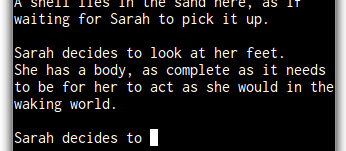
That was done by creating numerous objects of class “BodyPart” (or some similar name) which just generate error messages. Not sure if it was a tremendous breakthrough. But I think there is something to the idea of gently encouraging the interactor to o play within particular boundaries.
Emily’s slides (offering many other insights) may be posted in a bit – she is still traveling. I’ll link them here, if so.
Update! Emily’s slides are now online — please take a look.
I had a trio of questions for each pair of presenters, and we had time for questions from the audience, too. The three main presenters each had really great, compact presentations that gave a critical survey of these insurgent areas, and we managed to see a bit of how they speak to each other, too. This session, and getting to talk with these three during and outside of it, certainly made SXSW Interactive worth the trip for me.
There’s an audio recording of the event that’s available, too.
Christian Bök’s The Xenotext Book I at MIT
Christian read late last semester in the Purple Blurb series, a Trope Tank and CMS/W production. Here’s a video record of this appearance of his at MIT:


